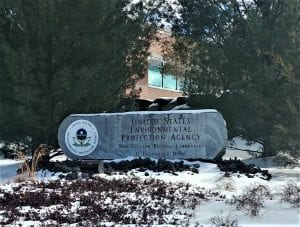
EPA New England sign. (Photo submitted)
Westfield Gas + Electric and Whip City Fiber are providing FREE online access to The Westfield News from 2/16-2/22. Please support local journalism by getting a subscription to The Westfield News.
WESTFIELD – On Feb. 14, the Environmental Protection Agency (EPA) issued a PFAS Action Plan, about which Acting EPA Director Andrew Wheeler said in his announcement: “The PFAS Action Plan is the most comprehensive cross-agency plan to address an emerging chemical of concern ever undertaken by EPA.” However, community action groups, including members of the Westfield Residents Advocating for Themselves (WRAFT) said the plan fails to prevent current and future exposure to PFAS in the environment.
“While we appreciate the work that went into this document, and the future actions it promises, today’s announcement changes nothing for PFAS victims in Westfield,” said Kristen Mello of WRAFT.
Mello said that members of WRAFT traveled to EPA’s New England Regional Laboratory in North Chelmsford, MA for their regional press conference, where EPA Office of Chemical Safety and Pollution Prevention (OCSPP) Assistant Administrator – and former EPA New England Regional Administrator – Alexandra Dunn unveiled the Per- and Polyfluoroalkyl Substances (PFAS) Action Plan. Dunn then fielded questions about the EPA’s plan from WRAFT, and fellow National PFAS Contamination Coalition groups from the affected communities of Merrimack and Portsmouth, NH.
The Action Plan describes long- and short-term actions that the EPA is taking including:
• Drinking water: EPA is moving forward with the maximum contaminant level (MCL) process outlined in the Safe Drinking Water Act for PFOA and PFOS—two of the most well-known and prevalent PFAS chemicals. By the end of this year, EPA will propose a regulatory determination, which is the next step in the Safe Drinking Water Act process for establishing an MCL.
• Clean up: EPA has already begun the regulatory development process for listing PFOA and PFOS as hazardous substances and will issue interim groundwater cleanup recommendations for sites contaminated with PFOA and PFOS. This important work will provide additional tools to help states and communities address existing contamination and enhance the ability to hold responsible parties accountable.
• Enforcement: EPA will use available enforcement tools to address PFAS exposure in the environment and assist states in enforcement activities.
• Monitoring: EPA will propose to include PFAS in nationwide drinking water monitoring under the next Unregulated Contaminant Monitoring Program. The agency will also consider PFAS chemicals for listing in the Toxics Release Inventory to help the agency identify where these chemicals are being released.
• Research: EPA will develop new analytical methods so that more PFAS chemicals can be detected in drinking water, in soil, and in groundwater. These efforts will improve our ability to monitor and assess potential risks. EPA’s research efforts also include developing new technologies and treatment options to remove PFAS from drinking water at contaminated sites.
• Risk Communications: EPA will work across the agency—and the federal government—to develop a PFAS risk communication toolbox that includes materials that states, tribes, and local partners can use to effectively communicate with the public.
• Together, these efforts will help EPA and its partners identify and better understand PFAS contaminants generally, clean up current PFAS contamination, prevent future contamination, and effectively communicate risk with the public. To implement the Action Plan, EPA will continue to work in close coordination with multiple entities, including other federal agencies, states, tribes, local governments, water utilities, industry, and the public.
“For the first time in Agency history, we utilized all of our program offices to construct an all-encompassing plan to help states and local communities address PFAS and protect our nation’s drinking water. We are moving forward with several important actions, including the maximum contaminant level process, that will help affected communities better monitor, detect, and address PFAS,” Wheeler stated in his release.
In a press release from the National PFAS Contamination Coalition, members of affected communities criticized the plan for failing to establish a Maximum Contaminant Level (MCL) for PFAS, to designate PFAS as a hazardous substance, and to define a cleanup strategy, saying they expected more from the EPA.
“Comments we heard today such as ‘in process’, ‘committed to’, and ‘very soon’ we have now heard for years,” said Loreen Hackett of #PFOAProjectNY. “Two decades of information and the solid science, which includes the recent CDC report, absolutely showing lowering risk levels is necessary to be protective of health, isn’t enough to yet set MCLs? It’s insulting to all of us exposed. Woefully inadequate is an understatement.”
While all of these areas are under study, the action plan puts a two-year time frame on the short-term goals, and greater than two years on long-term goals. In seeking funding for a $13 million bond to address Westfield’s water contamination last spring, Mayor Brian P. Sullivan had said that EPA action was at least two years away.
According to the non-profit Environmental Working Group, congress has already passed legislation to study PFAS’ health effects. Bipartisan bills to monitor PFAS in drinking water sources and accelerate PFAS cleanup at military bases were introduced last Congress, and a bill to designate PFAS a hazardous substance under Superfund has been reintroduced this session.
WRAFT is also calling on Westfield residents to support the creation of a bipartisan legislative task force on PFAS in Massachusetts.
The entire 72-page EPA Action Plan, which was developed following a National Leadership Summit on PFAS in May, 2018, visits to impacted communities, and information received from approximately 120,000 comments submitted in the public docket, is available on the EPA website at www.epa.gov.








